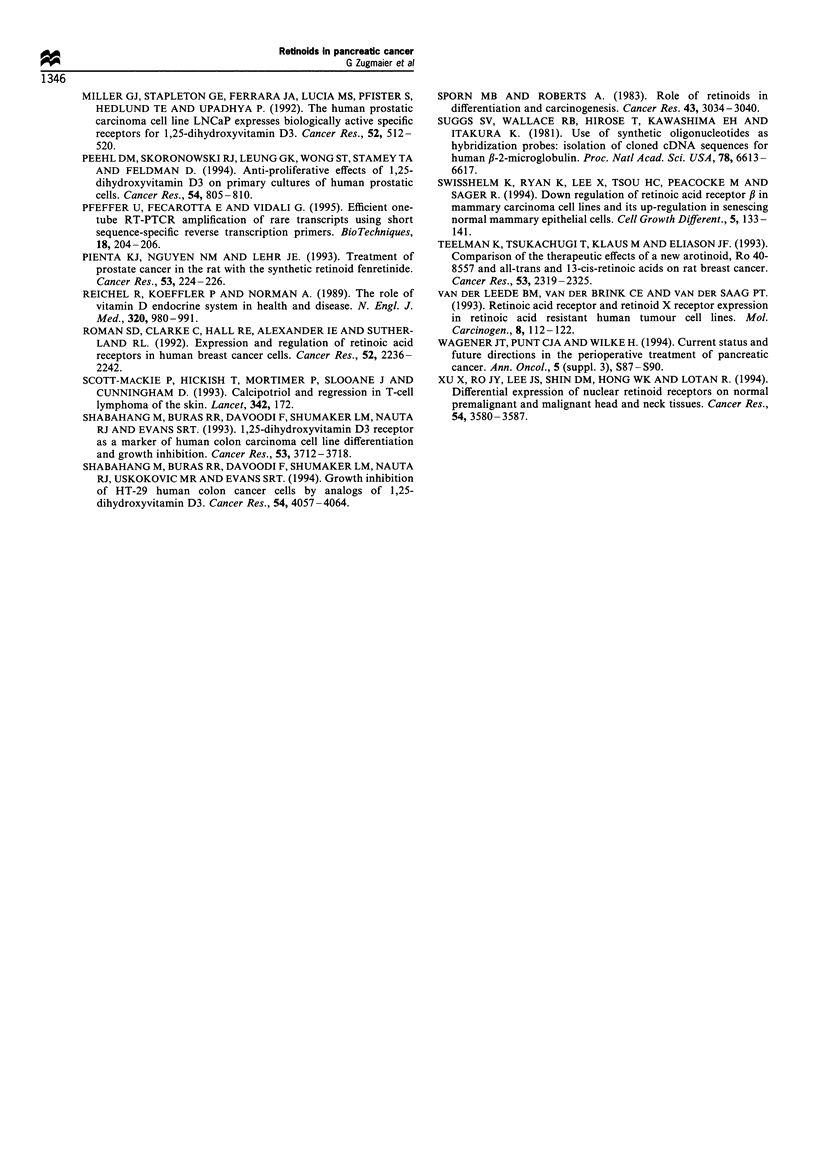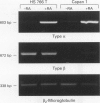Abstract
Retinoids and vitamin D are important factors that regulate cellular growth and differentiation. An additive growth-inhibitory effect of retinoids and vitamin D analogues has been demonstrated for human myeloma, leukaemic and breast cancer cells. We set out to study the effects of the vitamin D analogue EB1089 and the retinoids all-trans- and 9-cis-retinoic acid on the human pancreatic adenocarcinoma cell lines Capan 1 and Capan 2 and the undifferentiated pancreatic carcinoma cell line Hs766T. The cell lines investigated expressed vitamin D receptor, retinoic acid receptor (RAR)-alpha and gamma as determined by polymerase chain reaction after reverse transcription. RAR-beta was expressed only in Hs766T cells. Addition of all-trans-retinoic acid increased the amount of RAR-alpha mRNA in the three cell lines and induced RAR-beta mRNA in Capan 1 and Capan 2 cells. All-trans-retinoic acid at a concentration of 10 nM inhibited the growth of Capan 1 and Capan 2 cells by 40% relative to controls. 9-cis-Retinoic acid was less effective. Neither all-trans-retinoic acid nor 9-cis-retinoic acid affected the growth of Hs766T cells. EB1089, if added alone to the cells, did not significantly inhibit growth. However, the combination of 1 nM EB1089 with 10 nM all-trans-retinoic acid exerted a growth-inhibitory effect of 90% in Capan 1 cells and of 70% in Capan 2 cells. Our data suggest that vitamin D analogues together with retinoids inhibit the growth of human pancreatic cancer cells. However, in vivo studies are necessary to examine the potential use of retinoids and vitamin D analogues on pancreatic cancer.
Full text
PDF





Images in this article
Selected References
These references are in PubMed. This may not be the complete list of references from this article.
- Bollag W., Holdener E. E. Retinoids in cancer prevention and therapy. Ann Oncol. 1992 Jul;3(7):513–526. doi: 10.1093/oxfordjournals.annonc.a058252. [DOI] [PubMed] [Google Scholar]
- Colston K. W., Mackay A. G., James S. Y., Binderup L., Chander S., Coombes R. C. EB1089: a new vitamin D analogue that inhibits the growth of breast cancer cells in vivo and in vitro. Biochem Pharmacol. 1992 Dec 15;44(12):2273–2280. doi: 10.1016/0006-2952(92)90669-a. [DOI] [PubMed] [Google Scholar]
- Colston K. W. New concepts in hormone receptor action. Lancet. 1993 Jul 10;342(8863):67–68. doi: 10.1016/0140-6736(93)91281-p. [DOI] [PubMed] [Google Scholar]
- Cross H. S., Pavelka M., Slavik J., Peterlik M. Growth control of human colon cancer cells by vitamin D and calcium in vitro. J Natl Cancer Inst. 1992 Sep 2;84(17):1355–1357. doi: 10.1093/jnci/84.17.1355. [DOI] [PubMed] [Google Scholar]
- Doré B. T., Uskokovìc M. R., Momparler R. L. Interaction of retinoic acid and vitamin D3 analogs on HL-60 myeloid leukemic cells. Leuk Res. 1993 Sep;17(9):749–757. doi: 10.1016/0145-2126(93)90108-w. [DOI] [PubMed] [Google Scholar]
- Eliason J. F., Kaufmann F., Tanaka T., Tsukaguchi T. Anti-proliferative effects of the arotinoid Ro 40-8757 on human cancer cell lines in vitro. Br J Cancer. 1993 Jun;67(6):1293–1298. doi: 10.1038/bjc.1993.240. [DOI] [PMC free article] [PubMed] [Google Scholar]
- Evans R. M. The steroid and thyroid hormone receptor superfamily. Science. 1988 May 13;240(4854):889–895. doi: 10.1126/science.3283939. [DOI] [PMC free article] [PubMed] [Google Scholar]
- Formelli F., Cleris L. Synthetic retinoid fenretinide is effective against a human ovarian carcinoma xenograft and potentiates cisplatin activity. Cancer Res. 1993 Nov 15;53(22):5374–5376. [PubMed] [Google Scholar]
- Geradts J., Chen J. Y., Russell E. K., Yankaskas J. R., Nieves L., Minna J. D. Human lung cancer cell lines exhibit resistance to retinoic acid treatment. Cell Growth Differ. 1993 Oct;4(10):799–809. [PubMed] [Google Scholar]
- Gudas L. J. Retinoids, retinoid-responsive genes, cell differentiation, and cancer. Cell Growth Differ. 1992 Sep;3(9):655–662. [PubMed] [Google Scholar]
- Harant H., Korschineck I., Krupitza G., Fazeny B., Dittrich C., Grunt T. W. Retinoic acid receptors in retinoid responsive ovarian cancer cell lines detected by polymerase chain reaction following reverse transcription. Br J Cancer. 1993 Sep;68(3):530–536. doi: 10.1038/bjc.1993.381. [DOI] [PMC free article] [PubMed] [Google Scholar]
- Lotan R., Xu X. C., Lippman S. M., Ro J. Y., Lee J. S., Lee J. J., Hong W. K. Suppression of retinoic acid receptor-beta in premalignant oral lesions and its up-regulation by isotretinoin. N Engl J Med. 1995 May 25;332(21):1405–1410. doi: 10.1056/NEJM199505253322103. [DOI] [PubMed] [Google Scholar]
- Miller G. J., Stapleton G. E., Ferrara J. A., Lucia M. S., Pfister S., Hedlund T. E., Upadhya P. The human prostatic carcinoma cell line LNCaP expresses biologically active, specific receptors for 1 alpha,25-dihydroxyvitamin D3. Cancer Res. 1992 Feb 1;52(3):515–520. [PubMed] [Google Scholar]
- Peehl D. M., Skowronski R. J., Leung G. K., Wong S. T., Stamey T. A., Feldman D. Antiproliferative effects of 1,25-dihydroxyvitamin D3 on primary cultures of human prostatic cells. Cancer Res. 1994 Feb 1;54(3):805–810. [PubMed] [Google Scholar]
- Pfeffer U., Fecarotta E., Vidali G. Efficient one-tube RT-PCR amplification of rare transcripts using short sequence-specific reverse transcription primers. Biotechniques. 1995 Feb;18(2):204–206. [PubMed] [Google Scholar]
- Pienta K. J., Nguyen N. M., Lehr J. E. Treatment of prostate cancer in the rat with the synthetic retinoid fenretinide. Cancer Res. 1993 Jan 15;53(2):224–226. [PubMed] [Google Scholar]
- Reichel H., Koeffler H. P., Norman A. W. The role of the vitamin D endocrine system in health and disease. N Engl J Med. 1989 Apr 13;320(15):980–991. doi: 10.1056/NEJM198904133201506. [DOI] [PubMed] [Google Scholar]
- Roman S. D., Clarke C. L., Hall R. E., Alexander I. E., Sutherland R. L. Expression and regulation of retinoic acid receptors in human breast cancer cells. Cancer Res. 1992 Apr 15;52(8):2236–2242. [PubMed] [Google Scholar]
- Scott-Mackie P., Hickish T., Mortimer P., Sloane J., Cunningham D. Calcipotriol and regression in T-cell lymphoma of skin. Lancet. 1993 Jul 17;342(8864):172–172. doi: 10.1016/0140-6736(93)91373-t. [DOI] [PubMed] [Google Scholar]
- Shabahang M., Buras R. R., Davoodi F., Schumaker L. M., Nauta R. J., Evans S. R. 1,25-Dihydroxyvitamin D3 receptor as a marker of human colon carcinoma cell line differentiation and growth inhibition. Cancer Res. 1993 Aug 15;53(16):3712–3718. [PubMed] [Google Scholar]
- Shabahang M., Buras R. R., Davoodi F., Schumaker L. M., Nauta R. J., Uskokovic M. R., Brenner R. V., Evans S. R. Growth inhibition of HT-29 human colon cancer cells by analogues of 1,25-dihydroxyvitamin D3. Cancer Res. 1994 Aug 1;54(15):4057–4064. [PubMed] [Google Scholar]
- Sporn M. B., Roberts A. B. Role of retinoids in differentiation and carcinogenesis. Cancer Res. 1983 Jul;43(7):3034–3040. [PubMed] [Google Scholar]
- Suggs S. V., Wallace R. B., Hirose T., Kawashima E. H., Itakura K. Use of synthetic oligonucleotides as hybridization probes: isolation of cloned cDNA sequences for human beta 2-microglobulin. Proc Natl Acad Sci U S A. 1981 Nov;78(11):6613–6617. doi: 10.1073/pnas.78.11.6613. [DOI] [PMC free article] [PubMed] [Google Scholar]
- Swisshelm K., Ryan K., Lee X., Tsou H. C., Peacocke M., Sager R. Down-regulation of retinoic acid receptor beta in mammary carcinoma cell lines and its up-regulation in senescing normal mammary epithelial cells. Cell Growth Differ. 1994 Feb;5(2):133–141. [PubMed] [Google Scholar]
- Teelmann K., Tsukaguchi T., Klaus M., Eliason J. F. Comparison of the therapeutic effects of a new arotinoid, Ro 40-8757, and all-trans- and 13-cis-retinoic acids on rat breast cancer. Cancer Res. 1993 May 15;53(10 Suppl):2319–2325. [PubMed] [Google Scholar]
- Xu X. C., Ro J. Y., Lee J. S., Shin D. M., Hong W. K., Lotan R. Differential expression of nuclear retinoid receptors in normal, premalignant, and malignant head and neck tissues. Cancer Res. 1994 Jul 1;54(13):3580–3587. [PubMed] [Google Scholar]
- van der Leede B. M., van den Brink C. E., van der Saag P. T. Retinoic acid receptor and retinoid X receptor expression in retinoic acid-resistant human tumor cell lines. Mol Carcinog. 1993;8(2):112–122. doi: 10.1002/mc.2940080208. [DOI] [PubMed] [Google Scholar]





